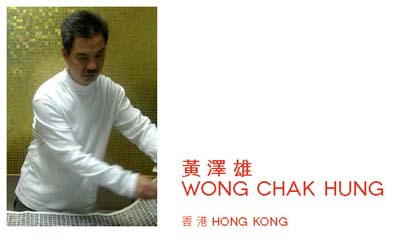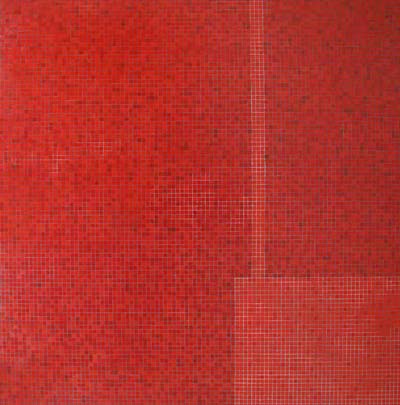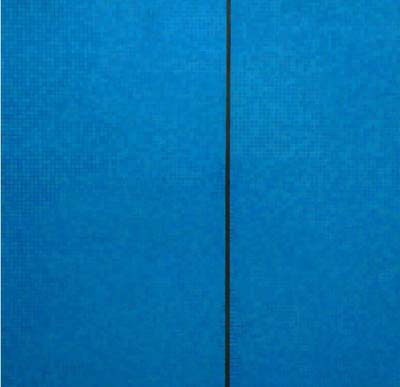
1963 年生
1989 結業於中央美術學院油畫系助教班
1993 參加台灣亞洲藝術博覽會及舉辦個展
1994 台灣小雅畫廊舉辦個展
1999 香港大一設計學院舉辦個展
2000 香港浸會大學舉辦個展
2005 香港牛棚藝術村舉辦個展
2009 香港藝穗會舉辦〝黃澤雄的藝術空間〞
2009 入選第十一届全國美術展
作品被香港文化博物館、香港大學馮平山博物館、香港理工大學及香港浸會大學等學術機構收藏。
Wong was born in Hong Kong and
studied painting in Beijing’s The Central
Academy of Fine Arts, one of the budding
grounds of CHINA’S AVANT-GARDE
ART since the mid-1980s. He left the
Academy and returned to Hong Kong on
June 3, 1989 for professional practice. It
was only until recently that his paintings
were exhibited in Hong Kong, though his
works have been collected by Taiwan’s
collectors, Hong Kong Heritage Museum
and, University Museum and Art Gallery
of The University of Hong Kong, among
many others.


UNTITLED(Red)
200X200CM
oil on canvas
UNTITLED (BLUE)
200X200CM
OIL ON canvas
黃澤雄自二千年起便選擇利用地下鐵內最尋常不過、帶有香港地緣色彩的階磚石/ 紙皮石、以1:1的真實比例,讓小小方格子作為其藝術冥想的對像,並以此發展、創作成他那種富標簽性、有別於中國和香港主流的巨幅單色油畫和水墨作品。西方古文化中早有彩油磚鑲嵌畫的製作,並藉此永久承傳西方宗教藝術的傳統 (見公元前六世紀巴比倫帝國的伊修塔爾城門鑲嵌畫) 這種格子畫的藝術含量和文化厚道並非當代部分平面抽象繪畫 (如日本村上隆的「超平面 (Super-Flat)」繪畫)可比擬;黃澤雄每天默寫紙皮石/ 階磚石的方法,不難理解其作品的歷史源頭,當中亦大有晉、唐經生練字、養生修練的神粹,故其精神性繪畫是傳统中國藝術的一種延伸、不能驟眼以平常的方法觀察。淺白普及的藝術未經觀眾消化,有時就出現一種理解上的危機,即愈淺白的作品愈易明便愈危險! 但作品走觀念形上路線也不等於藝術性愈高;觀念藝術家丹尼.寶雲 (Daniel Buren) 更指出沒有視覺張力的觀念藝術不是好作品。正如今年《柏林雙年展》相信藝術有改變社會現實的可見能力、但由於看
輕視覺元素的實驗探討,大量把紀實性質的政治行為、社會抗爭的行動成果作為視覺展覽報告形式,所帶來的非議便值得討論。
Wong has for years taken the MTR mosaic as the oeuvre
for his spiritual mediation of this bustling city. His
squares and the MTR mosaics are all in the same size
of 1:1; his paintings are all 100% comprising simulations
of urban situations that his hyper-realistic counterparts
can never dream of. In China and Asia, hundreds and
thousands of artists pretend to be clever’ and conceptual
and his relationship to art is, on the contrary, “100%
STUPID AND 100% REALISTIC TO APPROACH THE
URBAN CONDITION” (Wong CH). While issue matters,
Chinese philosophy is deeply embedded in Wong’s
mind. His mosaic paintings are neither imbued with the
western illusionistic depth and perspective, nor forging
a virtual historical dialogue. They have reflected Wong’s
profound skepticism of the illusionary living reality, as
well as the western realism and its overarching ideologies
in art. “Urban reality is not equal to reason and
painting is not intended for truth reproduction and the
‘realistic’ may not reflect that of reality…,” says Wong
Chak Hung. His painting field could be the found MTR
one day and not only his work has a tactile power which
can seemingly remove the viewers from reality mentally,
but also physically from where they are… If his paintings
can be correlatively staged as public ensemble
or contemplative space of installation, the conditioned
boundaries, relationships and perspectives between
the public spaces of MTR and private works of Wong
can be shifted and even obliterated, making his work
ever ‘contemporary’ at any given point in Hongkong’s
art history.